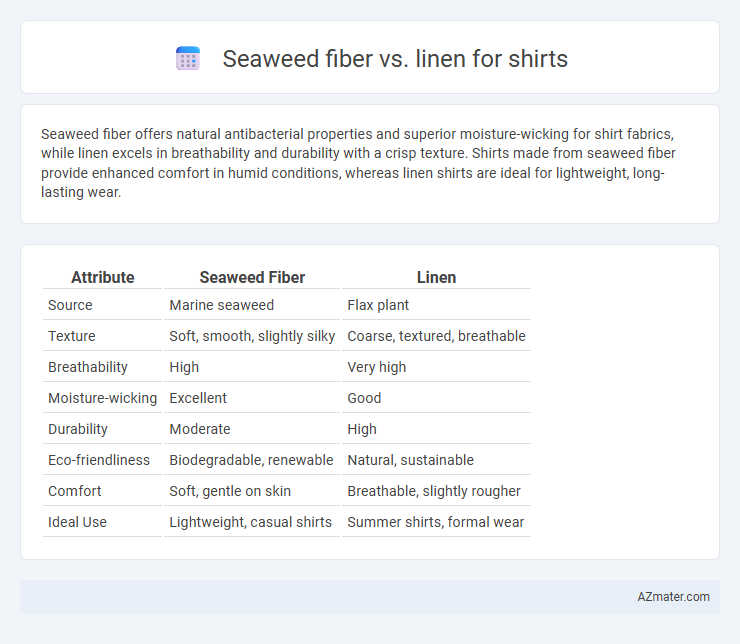Seaweed fiber offers natural antibacterial properties and superior moisture-wicking for shirt fabrics, while linen excels in breathability and durability with a crisp texture. Shirts made from seaweed fiber provide enhanced comfort in humid conditions, whereas linen shirts are ideal for lightweight, long-lasting wear.
Table of Comparison
| Attribute | Seaweed Fiber | Linen |
|---|---|---|
| Source | Marine seaweed | Flax plant |
| Texture | Soft, smooth, slightly silky | Coarse, textured, breathable |
| Breathability | High | Very high |
| Moisture-wicking | Excellent | Good |
| Durability | Moderate | High |
| Eco-friendliness | Biodegradable, renewable | Natural, sustainable |
| Comfort | Soft, gentle on skin | Breathable, slightly rougher |
| Ideal Use | Lightweight, casual shirts | Summer shirts, formal wear |
Introduction to Seaweed Fiber and Linen Shirts
Seaweed fiber, derived from sustainably harvested marine algae, offers natural antibacterial and moisture-wicking properties, making it an innovative choice for eco-friendly shirt fabrics. Linen, made from flax plant fibers, is renowned for its breathability, durability, and lightweight texture, ideal for warm-weather clothing. Both materials present sustainable alternatives to conventional cotton, with seaweed fiber emphasizing biodegradability and skin benefits, while linen delivers classic comfort and long-lasting wear.
Origin and Production Processes
Seaweed fiber for shirts is derived from sustainably harvested seaweed through a process that involves extracting cellulose to create biodegradable fabric with minimal environmental impact. Linen originates from the flax plant, where fibers are extracted through retting, combing, and spinning, resulting in a natural, durable textile known for breathability and strength. Both fibers emphasize eco-friendly production, but seaweed fiber leverages marine resources while linen relies on terrestrial crops.
Sustainability and Environmental Impact
Seaweed fiber offers a highly sustainable alternative to traditional textiles due to its biodegradable nature and low water consumption during production, significantly reducing environmental impact compared to linen. While linen, derived from flax plants, is biodegradable and uses fewer pesticides than cotton, its cultivation still demands considerable water resources and land use, potentially stressing ecosystems. Seaweed fiber's ability to regenerate quickly without chemical fertilizers or irrigation positions it as a more eco-friendly choice for sustainable shirt manufacturing.
Comfort and Softness Comparison
Seaweed fiber shirts offer exceptional softness due to their natural bioactive compounds and smooth texture, providing a gentle feel on the skin often compared to silk. Linen, made from flax fibers, is breathable and durable but tends to have a coarser texture that softens over time with wear and washing. When prioritizing immediate comfort, seaweed fiber outperforms linen in softness, making it an ideal choice for sensitive skin and lightweight apparel.
Breathability and Moisture-Wicking Abilities
Seaweed fiber offers superior breathability due to its natural porous structure, enhancing airflow and keeping the skin cool during wear. Its moisture-wicking abilities efficiently draw sweat away from the body, promoting faster evaporation compared to traditional linen. Linen, while breathable and moisture-absorbent, tends to retain dampness longer, making seaweed fiber a more effective choice for high-performance, moisture management in shirts.
Durability and Lifespan
Seaweed fiber shirts offer moderate durability with natural antimicrobial properties that enhance freshness but generally have a shorter lifespan compared to linen. Linen fabric is renowned for its exceptional strength and longevity, often lasting for many years due to its tightly woven flax fibers. While seaweed fiber provides sustainable benefits, linen remains the superior choice for durability and long-term wear in shirts.
Hypoallergenic Properties
Seaweed fiber exhibits exceptional hypoallergenic properties due to its natural antimicrobial and anti-inflammatory compounds, making it ideal for sensitive skin and reducing the risk of irritation and allergic reactions. Linen, derived from flax plants, is also hypoallergenic and highly breathable, minimizing moisture buildup that can trigger skin sensitivities. Compared to linen, seaweed fiber offers enhanced skin-soothing benefits, making it a superior choice for allergy-prone individuals seeking comfort and durability in shirts.
Style and Aesthetic Qualities
Seaweed fiber offers a unique, eco-friendly texture with a soft drape and subtle sheen that enhances shirt designs with a modern, sustainable appeal. Linen provides a classic, slightly rougher texture with natural wrinkles and breathability, creating a timeless, casual elegance favored in warm climates. Both fibers bring distinct aesthetic qualities: seaweed fiber emphasizes innovation and smooth sophistication, while linen highlights tradition and a relaxed, organic look.
Care and Maintenance Requirements
Seaweed fiber shirts require gentle washing with mild detergent and air drying to preserve their softness, while linen shirts benefit from cold water washes and ironing to maintain their crisp texture. Both fabrics should avoid bleach and high heat to prevent damage and color fading. Linen tends to wrinkle easily, demanding more frequent ironing compared to the naturally wrinkle-resistant seaweed fiber.
Price Points and Market Availability
Seaweed fiber shirts are emerging as eco-friendly alternatives often priced higher due to limited production and niche market appeal, typically ranging between $50 to $150. Linen shirts, widely available and produced on a large scale, generally offer more affordable options, with prices commonly spanning $30 to $100 depending on quality. Market availability of linen outpaces seaweed fiber, as linen benefits from established supply chains and global demand in both mass and premium segments.

Infographic: Seaweed fiber vs Linen for Shirt
 azmater.com
azmater.com